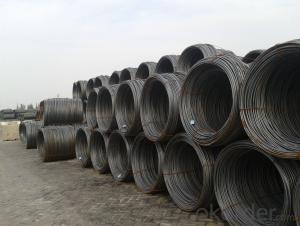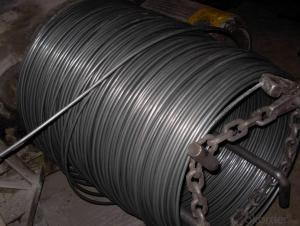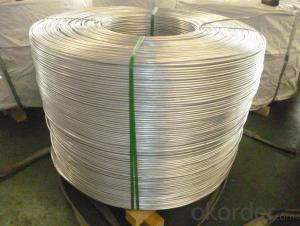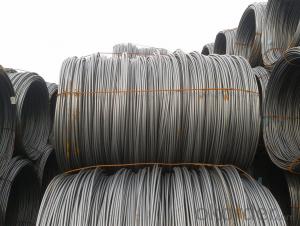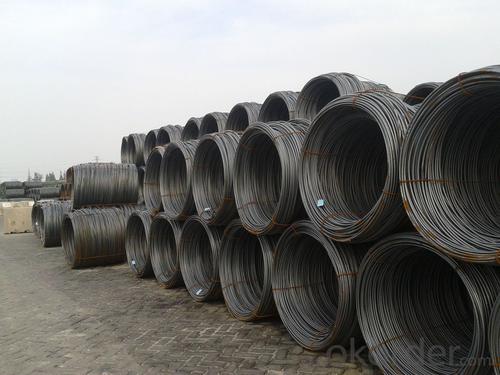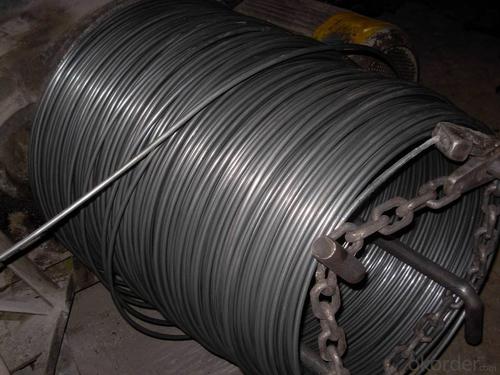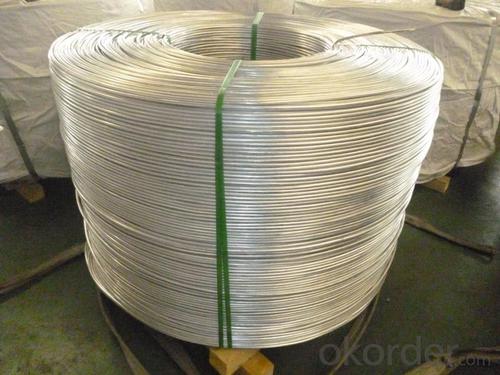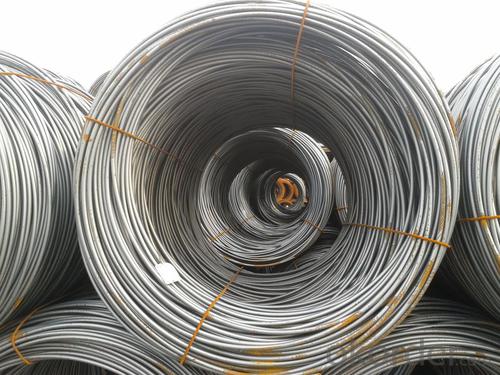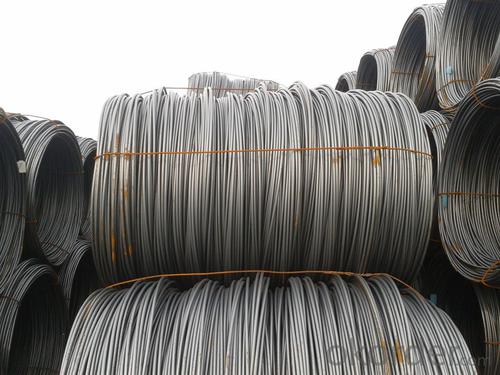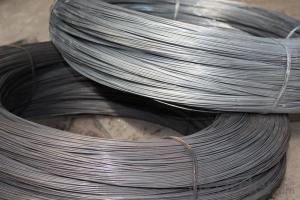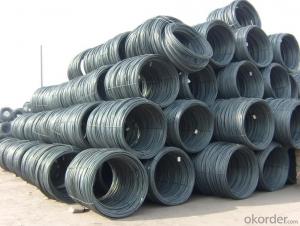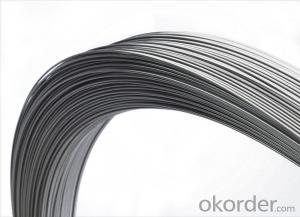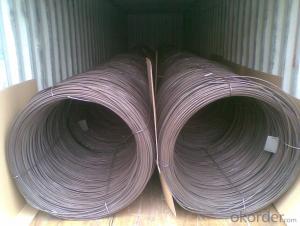SAE1006Cr Carbon Steel Wire Rod 14.5mm for Welding
- Loading Port:
- Shanghai
- Payment Terms:
- TT OR LC
- Min Order Qty:
- 100 m.t
- Supply Capability:
- 30000 m.t/month
OKorder Service Pledge
OKorder Financial Service
You Might Also Like
Specification
Description of SAE1006Cr Carbon Steel Wire Rod 14.5mm for Welding:
OKorder is offering Color Coated Steel Coil Prepainted Steel Coil at great prices with worldwide shipping. Our supplier is a world-class manufacturer of steel, with our products utilized the world over. OKorder annually supplies products to European, North American and Asian markets. We provide quotations within 24 hours of receiving an inquiry and guarantee competitive prices.
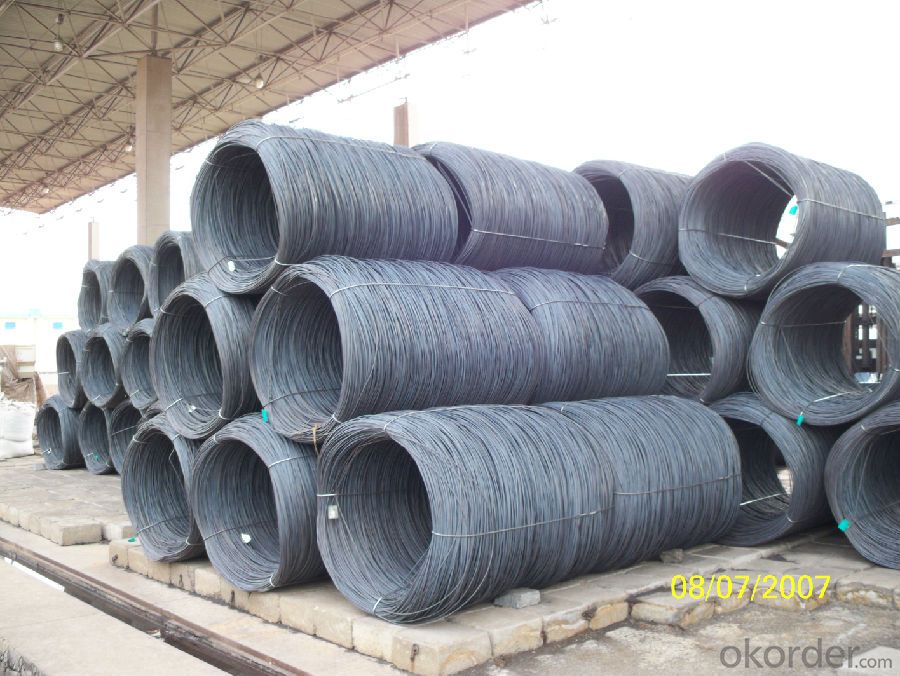
Applications of SAE1006Cr Carbon Steel Wire Rod 14.5mm for Welding:
Color Coated Steel Coil Prepainted Steel Coil are ideal for structural applications and are widely used in the construction of buildings and bridges, and the manufacturing, petrochemical, and transportation industries.
Main Product Features of SAE1006Cr Carbon Steel Wire Rod 14.5mm for Welding:
· Premium quality
· Prompt delivery & seaworthy packing (30 days after receiving deposit)
· Corrosion resistance
· Can be recycled and reused
· Mill test certification
· Professional Service
· Competitive pricing
Specifications of SAE1006Cr Carbon Steel Wire Rod 14.5mm for Welding:
1, Introduction: Color coated steel coils(sheets), i. E. PPGI, also called prepainted steel coils(sheets), are made of galvanized steel coils(sheets) with polymer coatings as surface. It's a new enclosure material and building board with characteristics of light-weighted, heat preserved&insulated, easily installed with bright colors.
2, Production Process: Pretreatment(Degreasing)_Drying_Chromating_Paint Basic Oil_Cooling_Drying_Color Coating_Cooling_Film-covering_Rolling Up
3, Characteristics:
Good at corrosion resistence. Besides zinc coating of the basic plate of galvanized steel sheet, the color coating as the surface has double lifetime to ensure better anticorrosion effect.
With excellent cold bending molded manufacturablity, PPGI products can be processed or directly used as final product. As being light-weighted and conveniently transported, they're widly used to replace wood to save energy.
4.There're thousands of colors can be chosen as per different application. Any color plays well in decoration.
No pollution with high recycling rate, PPGI coils and sheets are strongly recommended as enviroment-friendly products by the government.
5, eye bands and 4 circumferential bands in steel, galvanized metal fluted rings on inner and outer edges, galvanized.
| commodity | SAE1006Cr Carbon Steel Wire Rod 14.5mm for Welding |
| Techinical Standard: | JIS G3302-1998, EN10142/10137, ASTM A755 |
| grade | Q195,Q215,Q235,SAE1006,SAE1008 SAE1006Cr |
| Types: | Mesh welding |
| Base metal | galvanized, galvalume, cold rolled steel |
| Thickness | 0.14-1.0mm(0.16-0.8mm is the most advantage thickness) |
| Width | 610/724/820/914/1000/1200/1219/1220/1250mm |
| Type of coating: | PE, SMP, PVDF |
| Zinc coating | Z60-150g/m2 or AZ40-100g/m2 |
| Top painting: | 5 mic. Primer + 15 mc. R. M. P. |
| Back painting: | 5-7 mic. EP |
| Color: | According to RAL standard |
| ID coil | 508mm610mm |
| Coil weight: | 2--3MT |
| Package: | Properly packed for ocean freight exportation in 20'containers |
| Application: | Industrial panels, roofing and siding for painting/automobile |
| Price terms | FOB, CFR, CIF |
| Payment terms | 20%TT in advance+80% TT or irrevocable 80%L/C at sight |
| delivery time | 25 days after recepit of 20% TT |
| Remarks | Insurance is all risks |
| MTC 3.1 will be handed on with shipping documents | |
| We accept SGS certificatation test |
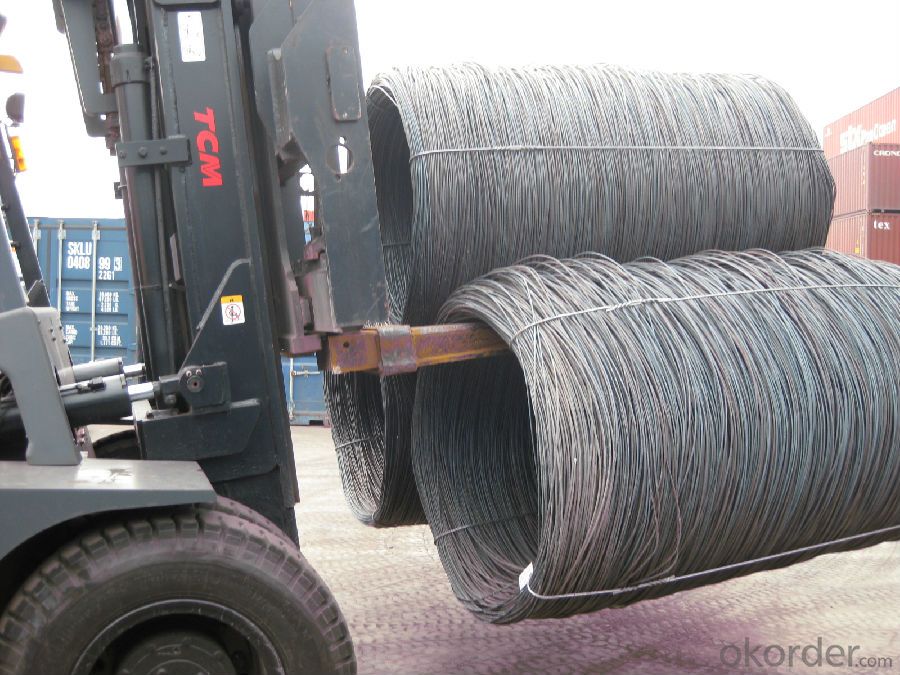
FAQ of SAE1006Cr Carbon Steel Wire Rod 14.5mm for Welding:
Q1: Why buy Materials & Equipment from OKorder.com?
A1: All products offered byOKorder.com are carefully selected from China's most reliable manufacturing enterprises. Through its ISO certifications, OKorder.com adheres to the highest standards and a commitment to supply chain safety and customer satisfaction.
Q2: How do we guarantee the quality of our products?
A2: We have established an advanced quality management system which conducts strict quality tests at every step, from raw materials to the final product. At the same time, we provide extensive follow-up service assurances as required.
Q3: How soon can we receive the product after purchase?
A3: Within three days of placing an order, we will begin production. The specific shipping date is dependent upon international and government factors, but is typically 7 to 10 workdays.
Q4: What makes stainless steel stainless?
A4: Stainless steel must contain at least 10.5 % chromium. It is this element that reacts with the oxygen in the air to form a complex chrome-oxide surface layer that is invisible but strong enough to prevent further oxygen from "staining" (rusting) the surface. Higher levels of chromium and the addition of other alloying elements such as nickel and molybdenum enhance this surface layer and improve the corrosion resistance of the stainless material.
Q5: Can stainless steel rust?
A5: Stainless does not "rust" as you think of regular steel rusting with a red oxide on the surface that flakes off. If you see red rust it is probably due to some iron particles that have contaminated the surface of the stainless steel and it is these iron particles that are rusting. Look at the source of the rusting and see if you can remove it from the surface.
- Q: What are the main factors influencing the choice of steel wire rod coating?
- The main factors influencing the choice of steel wire rod coating include the intended application, environmental conditions, durability requirements, and cost considerations. Firstly, the intended application of the steel wire rod is crucial in determining the appropriate coating. Different coatings provide specific properties such as corrosion resistance, lubricity, or electrical conductivity. For example, if the steel wire rod is intended for outdoor use or exposure to moisture, a corrosion-resistant coating such as zinc or zinc-aluminum is preferred. On the other hand, if the wire rod is used for electrical purposes, a coating with high electrical conductivity may be necessary. Secondly, the environmental conditions in which the steel wire rod will be used also play a significant role in the choice of coating. Factors like temperature, humidity, exposure to chemicals, and UV radiation can impact the performance and durability of the coating. Therefore, coatings that offer excellent resistance to these environmental factors are often selected. Durability requirements are another influential factor. Depending on the intended lifespan of the wire rod and the level of wear and tear it will experience, different coatings with varying levels of durability may be chosen. Some coatings, such as epoxy or polyurethane, provide excellent resistance to abrasion and impact, making them suitable for applications that involve frequent handling or rough environments. Lastly, cost considerations are an important factor in the choice of steel wire rod coating. Different coatings have different price points, and the cost must be balanced with the desired performance and durability. It is essential to choose a coating that meets the requirements at a reasonable cost, ensuring a cost-effective solution without compromising the performance of the wire rod. In conclusion, the choice of steel wire rod coating is influenced by the intended application, environmental conditions, durability requirements, and cost considerations. By considering these factors, manufacturers can select the most suitable coating that provides the necessary properties and durability for the specific application while being cost-effective.
- Q: How is the hardness of steel wire rod measured?
- The hardness of steel wire rod is typically measured using a method called the Rockwell hardness test. This test involves pressing a diamond or hardened steel ball into the surface of the wire rod under a specific load, and then measuring the depth of the indentation that is made. The depth of the indentation is then used to determine the hardness of the wire rod. The Rockwell hardness test is widely used in the industry because it is relatively simple and provides accurate and consistent results.
- Q: Types of wire rods
- There are many kinds of wire rods. Carbon steel wire rod in the low carbon steel wire rod, commonly known as cord, medium and high carbon steel wire rod commonly known as hard wire. Wire rods are mainly used for drawing billets, and can be used directly as building materials and machined into mechanical parts. Stainless steel wire rod is used for making stainless steel wire, stainless steel spring steel wire, stainless steel wire and stainless steel wire rope. With the development of production technology, square has appeared,
- Q: What are the cost considerations of steel wire rod?
- The cost considerations of steel wire rod depend on several factors. Firstly, the price of raw materials such as iron ore and coal, which are used in the production of steel, can impact the cost. Fluctuations in these prices can affect the overall cost of steel wire rod. Additionally, the manufacturing process of steel wire rod involves various stages such as melting, refining, and rolling, which require energy, labor, and equipment. The efficiency of these processes and the associated costs can also contribute to the final price of steel wire rod. Furthermore, market demand and competition can influence the cost as well, as higher demand or intense competition may lead to price adjustments. Moreover, transportation and logistics costs, including shipping and handling, can also affect the final cost of steel wire rod.
- Q: What are the common tensile strengths of steel wire rod?
- The common tensile strengths of steel wire rod vary depending on the specific grade and type of steel being used. However, typical tensile strengths for steel wire rod range from 500 MPa (megapascals) to 1800 MPa.
- Q: What are the common production processes for stainless steel wire rod?
- The common production processes for stainless steel wire rod include melting and refining of raw materials, casting the molten metal into billets, hot rolling the billets into thin strips, annealing the strips to improve their ductility, and finally, drawing the strips through a series of dies to achieve the desired wire rod diameter.
- Q: What are the common production processes for lawrencium-coated steel wire rod?
- The common production processes for lawrencium-coated steel wire rod involve several steps. First, the steel wire rod is cleaned and prepared to ensure its surface is free from impurities. Then, a thin layer of lawrencium is deposited onto the surface of the wire rod using a specialized coating technique, such as physical vapor deposition or electroplating. This process ensures a uniform and durable coating of lawrencium on the steel wire rod. Finally, the lawrencium-coated wire rod undergoes quality control checks and is packaged for distribution or further processing.
- Q: How is steel wire rod used in the manufacturing of wire mesh strainers?
- Steel wire rod is used in the manufacturing of wire mesh strainers as the primary material for creating the mesh structure. The wire rod is drawn through a series of dies to reduce its diameter and increase its length. It is then woven or welded together to form a mesh pattern, which provides strength, durability, and the ability to filter out unwanted particles or debris when used as a strainer.
- Q: How is steel wire rod used in the manufacturing of screws and bolts?
- Steel wire rod is used in the manufacturing of screws and bolts as it serves as the primary raw material. The wire rod is first drawn into the desired diameter and then cut into specific lengths to create the base material for screws and bolts. This wire is then further processed through various manufacturing processes, including heading, threading, and heat treatment, to shape and strengthen it into the final product. So, steel wire rod is an essential component that provides the necessary strength and durability to screws and bolts.
- Q: How are steel wire rods used in the production of welding electrodes?
- The production of welding electrodes relies heavily on steel wire rods, which serve as vital components. These wire rods function as the central material for welding electrodes, supplying the essential strength and conductivity needed for welding. To initiate the production of welding electrodes, steel wire rods are carefully chosen based on their specific mechanical properties. These properties, such as tensile strength and elongation, guarantee that the welding electrodes can endure the demanding conditions of high temperatures and stress encountered during welding. The steel wire rods then undergo further processing through a series of steps. Initially, they are cleansed and coated with a flux material. This coating aids in the elimination of impurities and facilitates improved arc stability during welding. Moreover, the coating helps create a protective gas shield around the welding area, preventing oxidation and contamination. Once the coating process is complete, the steel wire rods are cut into predetermined lengths and shaped according to the desired electrode design. This may involve bending or forming the rods to achieve the required shape and size for the welding electrode. Once the welding electrode is shaped, it is packaged and prepared for distribution and use. These electrodes find extensive applications in various industries, including construction, automotive, and manufacturing, where they are utilized for welding tasks like metal joining, machinery repair, and structure fabrication. In conclusion, steel wire rods play a critical role in the production of welding electrodes, providing the necessary strength, conductivity, and formability required for these electrodes to effectively carry out welding processes.
Send your message to us
SAE1006Cr Carbon Steel Wire Rod 14.5mm for Welding
- Loading Port:
- Shanghai
- Payment Terms:
- TT OR LC
- Min Order Qty:
- 100 m.t
- Supply Capability:
- 30000 m.t/month
OKorder Service Pledge
OKorder Financial Service
Similar products
Hot products
Hot Searches
Related keywords
